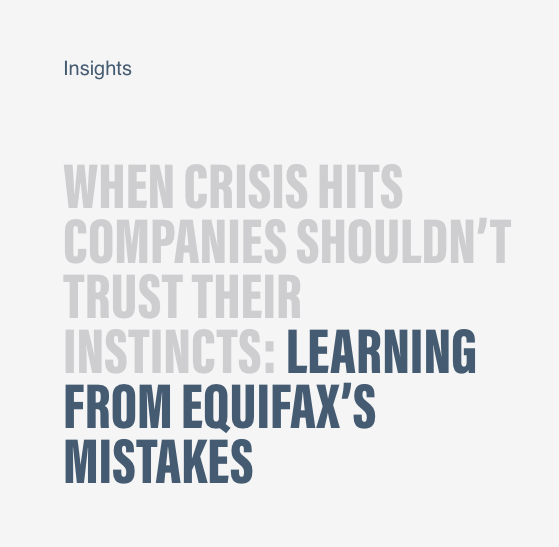Why you should expect the expected
Many of our clients across industries, sectors, and approaches are spending an increasing amount of time responding to issues that come up again and again. Not hair on fire crises, but a slow and steady drip of predictable questions, social media groups gone awry, customer concerns gone public, and media stories that get undue attention. The team here at m+p is always in the business of solving interesting and complex language challenges, and we’ve seen an uptick in our clients’ needs to have reactive messaging at-the-ready. Senior Vice President Maria Boos has decades of experience crafting language that resonates, for undiscovered and underserved framing challenges. We recently spoke with her about her passion for issue readiness. She explains why every company should be prepared with libraries of language that allow them to respond quickly, credibly, and consistently when “chatter” happens. Messaging designed to EXPECT THE EXPECTED gives you one more important arrow in your communications quiver.
m+p: Diving right in! What are the language strategy challenges around issue readiness?
MARIA: Companies apply vast resources to many categories of communication: brand building, marketing materials, crisis communications, et cetera. But readiness to respond with issues-based reactive messaging seems to be a neglected segment of the communications continuum. At m+p, we see it as our role to raise their consciousness about the importance to have reactive messaging at the ready–messaging they know has been well-calibrated and tested and optimized for the circumstances in which they’ll be using it.
m+p: If issue readiness and reactive messaging is so important, why aren’t more companies working more on this?
MARIA: I think this falls into a middle ground, which is perhaps why it’s overlooked. It’s not a hair-on-fire issue like “we have a data breach” or “the CEO behaved really badly.” It’s not the gargantuan topics of, say, sustainability or DEI. It’s more specific — and really connected to what the business does and the micro-topics in it.
For example, for a food or beverage company, there are a whole bunch of individual topics that are related to ingredient safety. In the pharma industry, the area of pricing garners constant attention. Or in financial services, there are hot buttons around fee structures and transparency of fees. They’re things that, on the one hand, our clients are dealing with all the time. And on the other hand, there is an aspect that’s falling through the cracks.
We come in and ask questions to help diagnose if there’s a hole in their overall communications architecture. And often we find they’ve got a well-oiled machine that springs into action to deal with UNEXPECTED issues or crises–and they have whole divisions devoted to the big issues like sustainability–but it’s no one’s job to focus on continual readiness to respond to the EXPECTED issues.
m+p: So while I understand the need for issue readiness, what makes m+p uniquely able to help? What’s our secret sauce in this?
MARIA: We have a very focused application of our approach to language strategy that is rooted in our foundational idea of “It’s not what you say, it’s what they hear®.” And we can apply it to a handful of topics and issues or a whole battery of them. So, we create a range of responses that address the issues that we want to test. Then we focus in on understanding what our key audiences hear from each approach. By testing a variety of language, we don’t just validate one approach; rather, we get deeper insights into what language resonates most. And what you get, as a result, isn’t just the messages proven to neutralize concern, change minds, and drive acceptance. You get a roadmap into the way your customers, influencers, and others THINK, which can help you in so many other areas.
m+p: What are the benefits of working with us on issue readiness and reactive messaging?
MARIA: Done right, companies gain confidence that the language is truly optimized for what resonates best with their key audiences. And that gives them a platform to ensure consistency across what are typically very siloed organizations by design. This work is a way to elevate consistent language that is applicable across divisional silos and ensure that any customer feels like they’re having a relationship with a single institution. And that any other interested party gets a consistent response in real time, no matter when or where they raise their concern.
m+p: Is there a lifespan for specific issues, at which point you’d say you need to go back and refresh this? What are the levers that you would look to for freshness of that messaging?
MARIA: It really follows what’s going on in marketplace. What have you been hearing? When the tenor of the questions or the urgency or the attitude behind them changes, that suggests there’s something going on in consumer sentiment–and there’s something new to address, or existing messaging needs to be refreshed to stay relevant. The other lever is what’s happening in the industry. Are there different players in the competitive set? Or changes in the regulatory environment? You have to be ready for people to ask “Why are you doing this differently?” or “Should you be doing this differently?” The shift may actually be to their advantage or for their protection, but people resist change. Depending on the industry, even changes in science are a factor. All of these might make us sit up and think differently or communicate differently.
m+p: You have helped clients prepare to respond for what is sometimes an onslaught of misinformation and abundant skepticism. What are some things you have learned that might be applicable for any business, regardless of sector?
MARIA: The first theme is understanding how much, or how little, to say. With the right amount of content prepared in advance, a company can then break that down into targeted answers when questions arise. There is something of an art in matching the right level of depth and specificity to the way the issue is raised. Having the library of messaging prepared allows you to do just that.
[The second theme] is how to ensure you remain separate from any marketing agenda. If this is truly to be issues-based reactive messaging, how can you ensure that you’re not going to expose yourself to criticism for turning it into a promotional opportunity?
[The third theme] is around curiosity. You must truly commit to understanding what the issues are, how they vary regionally or globally depending on where you operate, and what’s likely to influence the burning issues that either expose you to reputational risk or are missed opportunities to clarify the good that you’re doing in certain cases. The only way you can do that is to ask people who are on the ground — so research is essential. This can’t be a theoretical exercise. It must be grounded in the truth of your target audience and stakeholders.
And finally, when you do this and you do it well, you must commit to keeping the messaging fresh and relevant. Shifts in consumer sentiment, the policy environment–even scientific data–may require updates to the messaging. It’s not a one-and-done, but there’s certainly opportunity to control the cost by having the library of responses ready and being very thoughtful about the degree to which they need to be refreshed or tracked over time.
m+p: If you had to sum up why you believe in the importance of issue readiness and reactive messaging, what would you say?
MARIA: Again, a lot of resources are required to be ready to respond to the unexpected, and rightly so. You never want to divert the time and expertise of communicators from truly urgent issues. Instead, you can thoughtfully and efficiently build a library of reactive messaging so that it’s always ready when you need it. When you expect the expected, you can do it in a way that’s research-based, efficient, and optimized for consistency. It’s simply a good idea for one more arrow to put in your communications quiver.
To learn more about how maslansky + partners can help you build a library for issue readiness and preparedness, get in touch with us here.









